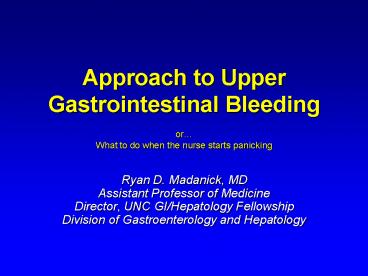Approach to Upper Gastrointestinal Bleeding - PowerPoint PPT Presentation
1 / 43
Title:
Approach to Upper Gastrointestinal Bleeding
Description:
Approach to Upper Gastrointestinal Bleeding or What to do when the nurse starts panicking Ryan D. Madanick, MD Assistant Professor of Medicine – PowerPoint PPT presentation
Number of Views:1273
Avg rating:3.0/5.0
Title: Approach to Upper Gastrointestinal Bleeding
1
Approach to Upper Gastrointestinal Bleeding
or What to do when the nurse starts panicking
- Ryan D. Madanick, MD
- Assistant Professor of Medicine
- Director, UNC GI/Hepatology Fellowship
- Division of Gastroenterology and Hepatology
2
The 300 AM Bleed
You are the covering intern for Med U. The nurse
from 8 Bedtower calls you to say that Mrs.
Johnson has just vomited blood. The nurse is
panicking because she doesnt like GI bleeds.
3
The 300 AM Bleed
- Do you
- Say Thanks, and hang up the phone
- Tell her that youre not covering Mrs. Johnson
- Call the resident or fellow cause you have no
idea what to do - Tell her youll be right there (after youve made
a quick telephone assessment)
4
The 300 AM Bleed
Your answer should no longer be C. Call your
resident cause you have no idea what to do You
should have said D. Tell her youll be right
there (after youve made a quick telephone
assessment)
5
Management of UGI Bleeding
Based on this case, we will discuss the acute
management of GI bleeding. You should learn
about
- Step 1 The Telephone Game
- Step 2 At The Bedside (the makeshift ER)
- Step 3 Calling for Reinforcement
6
Step OneThe Telephone Game
7
The Telephone Game
What do you need to know first?
- Vital signs
- Appearance (diaphoretic?)
- Amount of bleeding
- Anticoagulants?
8
The Telephone Game
BP 95/45 P 120 Pulse ox 93 on room air You
find out that she has just vomited about 250 cc
of coffee-ground material. She is somewhat
uncomfortable and diaphoretic. She is
hospitalized for unstable angina and is on
heparin and aspirin.
9
The Telephone Game
What should you tell the nurse?
- Start 2 large bore IVs
- Draw STAT labs
- Nasogastric tube to bedside
- Consider fluids, PPI, octreotide
- Hold anticoagulants
- Ill be right there
10
Step Two At The Bedside (the makeshift ER)
11
At The Bedside (the makeshift ER)
While usual medical teaching focuses around the
importance of an accurate history and physical,
the clinical status of the patient may make rapid
intervention more important than a prolonged
interview and examination.
12
At The Bedside (the makeshift ER)
What do you do now?
- Do a quick survey (ie, ABCs, general)
- Quick history and physical
- Cardiovascular/pulmonary status (TILT?)
- Abdominal exam
- Rectal
- START TREATING THE PATIENT
13
At The Bedside (the makeshift ER)
- Your rapid assessment
- Appears somewhat uncomfortable and diaphoretic
- Responsive and breathing normally
- Tachycardic with a thready pulse
- Mild epigastric tenderness with normoactive bowel
sounds - Not actively bleeding or passing melena
14
At The Bedside (the makeshift ER)
What intervention should you do now?
- Volume resuscitation
- Place nasogastric tube
- Lavage the stomach
- Correct coagulopathy
15
At The Bedside (the makeshift ER)
You decide to start normal saline wide open. You
successfully pass the nasogastric tube and lavage
with saline. The gastric contents contain clots
and coffee-ground material. After a liter the
lavage begins to clear and eventually you
withdraw bile. The tube is pulled.
16
At The Bedside (the makeshift ER)
What are some major concerns?
- Hypovolemic shock
- Certain etiologies
- Varices
- Vascular-enteric fistula
CALL SOMEONE IMMEDIATELY
17
Step ThreeCalling for Reinforcement
18
Calling for Reinforcement
What more needs to be done?
- Call someone (resident, unit team, GI, surgeon)
- Assess bleeding activity
- Review data (chart, HP, labs)
- Order (and follow) serial H/H
- Consider diagnostic studies
19
Calling for Reinforcement
You see that her admission hemoglobin was 10.5
g/dL and her STAT result is 9.9 g/dL. Her chart
review reveals that she is 65 and healthy, but
presented two days ago with unstable angina. Her
cardiopulmonary and renal function is relatively
normal. You decide to continue NS at 150
cc/hour, and you order H/H q6h. Her BP is now
128/80 and pulse is 90. She feels much better
and thanks you.
20
Calling for Reinforcement
You call the GI fellow, who applauds you for
managing the situation well. He schedules her
for an EGD in the morning. You ask the fellow
Shouldnt she be scoped NOW? Should we get a
bleeding scan or angiogram?
21
Calling for Reinforcement
The fellow explains that since the bleeding has
stopped (probably), angiography and nuclear
scintigraphy are unlikely to be positive.
Endoscopy can now be safely delayed until
morning, since the patient has been adequately
stabilized.
22
(No Transcript)
23
(No Transcript)
24
(No Transcript)
25
(No Transcript)
26
(No Transcript)
27
(No Transcript)
28
(No Transcript)
29
(No Transcript)
30
(No Transcript)
31
(No Transcript)
32
(No Transcript)
33
(No Transcript)
34
(No Transcript)
35
(No Transcript)
36
(No Transcript)
37
(No Transcript)
38
(No Transcript)
39
(No Transcript)
40
(No Transcript)
41
(No Transcript)
42
(No Transcript)
43
(No Transcript)































